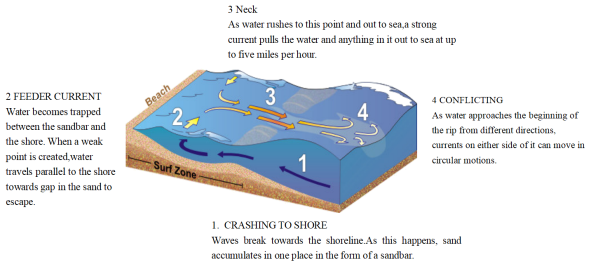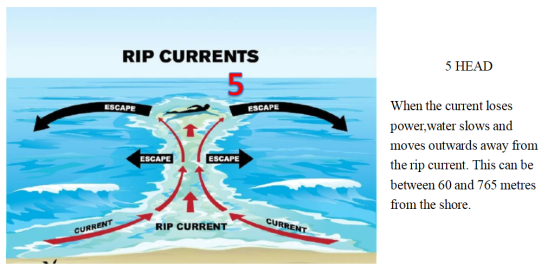1 . Two and a half months before the 2024 Atlantic hurricane season officially begins, forecasters have already predicted and warned that warm sea surface temperatures in the Atlantic and the development of a La Niña in the Pacific may create a “perfect storm” of the conditions needed for major hurricanes.
Key to the formation of any tropical cyclone (气旋) is the combination of warm ocean temperatures and the absence of what is known as wind shear. Alex DaSilva, a forecaster, explains that wind shear occurs when wind changes direction and speed at different heights in the atmosphere. When there’s much wind shear, it essentially knocks over those clouds and prevents tropical systems from really becoming stronger. Besides, hurricanes also need surface water to be at a temperature of 26 degrees Celsius or higher. That warm water, and the warm air just above it, provides fuel for the storm. The record data for February are 1.2 degrees Celsius above normal.
Over periods ranging from three to seven years, the waters of the central and eastern tropical Pacific Ocean alternately (交替地) warm and cool as a result of a repeatedly occurring climate pattern called the El Niño-Southern Oscillation (ENSO). During an El Niño, sea surface temperatures in the eastern Pacific increase, and those warmer temperatures affect the path of the Pacific jet stream, which in turn brings drier, warmer weather to the northern United States and Canada, and wetter conditions to the Gulf Coast and southeast. El Niño reduces the possibility of Atlantic hurricane formation because it lowers hurricane activity and increases wind shear. La Niña has just the opposite effect of El Niño. During the 2023 season, ENSO was in an El Niño phase. By the time the 2024 season starts, it is likely to have shifted fully into a La Niña.
“If a tropical storm system comes into this area, it could rapidly intensify, potentially close to land,” DaSilva cautions. “And that’s why people need to be on alert and have their hurricane plans ready. Because any system with these kinds of conditions can explode very quickly. That’s what we’re concerned about.”
1. Where can you probably read this article?| A.www.huffpost.com/entertainment/ |
| B.www.bbc.com/innovation/science |
| C.www.nationalgeographic.com/environment/ |
| D.www.nytimes.com/spotlight/global-culture-sports |
| A.The explanation of wind shear. |
| B.The timing of the hurricane season. |
| C.The process of hurricane formation. |
| D.The reason for warmer surface water. |
| A.Generate less wind shear. |
| B.More rainfall in the Gulf Coast. |
| C.Block the path of the Pacific jet stream. |
| D.Higher temperature in the northern America. |
| A.To report the hurricane-struck areas. |
| B.To remind people of getting prepared. |
| C.To introduce some geographic knowledge. |
| D.To explain the features of El Niño and La Niña. |
2 . WHAT ARE RIP CURRENTS?
Rip currents are like the rivers of the sea, transporting water near the shore back out into the ocean depths. The presence of these currents can be hidden by the wild movements of the surrounding waves. This means that as well as carrying seaweed and pieces of materials quickly out to sea, they can rapidly sweep away even the strongest swimmers. Around 80 percent of all lifeguard rescues are caused by powerful rip currents pulling a swimmer into danger.
If you find yourself being pulled out to sea by an unsuspected rip current, you should remain calm, focus on staying afloat and, if you can, swim parallel to the shore. Your instincts might tell you to swim towards land, as this is where you’re aiming to get to, but the current will be too strong to swim against. Instead, aim to move across the current and into slower flowing water next to it. A rip current may only pull you just past the breaking waves, but in some cases they can take you hundreds of metres offshore. The strength of currents can be hard to predict, so it’s safest to stay on lifeguarded beaches and not to swim if you see any indication of a rip current.


| A.prevent you from swimming into danger | B.transport water out into the ocean depths |
| C.clear away seaweed and pieces of materials | D.warn lifeguards against rescue in rip currents |
| A.difference between various currents | B.two types of zones off shore |
| C.an ideal route to surf in safety | D.how rip currents form |
| A.1000 metres off the shore beyond “HEAD”. | B.The channel through the gap in a sandbar. |
| C.The location where a red flag is erected. | D.Over the narrow stretch of a sandbar. |
1.
2.
3.
4.
4 . Standing on the shore of a lake, I can’t help but feel surprised at the thousands of small rocks that surround my boots. They were all created from
Even the tallest mountains have
But I’m not a
Two years ago, while traveling in the Pacific Northwest, I watched a restaurant owner ask several young men to
The group of young men wanted to
You can fit more rounded rocks in a jar than those with sharp edges. The former look for ways to
I placed a
| A.fragile | B.shiny | C.smooth | D.hard |
| A.piled up | B.worn down | C.risen up | D.broken down |
| A.will | B.voice | C.attitude | D.heart |
| A.Still | B.Often | C.Here | D.Once |
| A.understanding | B.confident | C.patient | D.competitive |
| A.contribute | B.exist | C.work | D.develop |
| A.fool | B.soul | C.rock | D.judge |
| A.explain | B.leave | C.apologize | D.pay |
| A.contradictory | B.confusing | C.forceful | D.discouraging |
| A.get through | B.stick to | C.deal with | D.fight against |
| A.think | B.care | C.talk | D.argue |
| A.even | B.however | C.anyway | D.also |
| A.hardships | B.struggle | C.experiences | D.failure |
| A.open | B.cautious | C.ambitious | D.independent |
| A.ignore | B.accept | C.adjust | D.change |
| A.excuse | B.agreement | C.entrance | D.inch |
| A.Nature | B.Tolerance | C.Tide | D.Time |
| A.reforming | B.seeing | C.exploring | D.travelling |
| A.sharp | B.rounded | C.valuable | D.rolling |
| A.class | B.belief | C.meeting | D.discussion |
5 . With no special equipment, no fences and no watering, two abandoned agricultural fields in the UK have been rewilded (重新野化), in large part due to the efforts of jays, which actually “engineered” these new woodlands. Researchers now hope that rewilding projects can take a more natural and hands-off approach and that jays can shed some of their bad reputations.
The two fields, which researchers have called the New Wilderness and the Old Wilderness, had been abandoned in 1996 and 1961 respectively. The former was a bare field, while the latter was grassland—both lay next to ancient woodlands. Researchers had suspected that the fields would gradually return to wilderness, but it was impressive to see just how quickly this happened, and how much of it was owed to birds.
Using aerial data, the researchers monitored the two sites. After just 24 years, the New Wilderness had grown into a young, healthy wood with 132 live trees per hectare, over half of which (57%) were oaks. Meanwhile, the Old Wilderness resembled a mature woodland after 39 years, with 390 trees per hectare.
“This native woodland restoration was approaching the structure (but not the species composition) of long-established woodlands within six decades,” the researchers explained in the study.
Part of this reforestation was done by the wind, and researchers suspect that previous ground disturbance may have aided the woodland establishment—which is good news, as it would suggest that agricultural areas may be reforested faster than anticipated. However, animals—Eurasian jays, thrushes, wood mice, and squirrels—also played an important role in helping the forests take shape. This handful of species provided much of the natural regeneration needed for the forest to develop. Jays, in particular, seem to have done a lot of heavy lifting.
1. What does the underlined word “shed” in Paragraph 1 refer to?| A.Be opposed to. |
| B.Be ashamed of. |
| C.Get used to. |
| D.Get rid of. |
| A.The scale of the woodlands. |
| B.The diversity of the fields. |
| C.The rate of the changes. |
| D.The frequency of the wilderness. |
| A.The woodland restoration was approaching the structure of long-established ones. |
| B.Much of the wilderness of the fields was owed to birds. |
| C.Previous ground disturbance aided the woodland establishment. |
| D.How quickly the fields returned to wilderness over time. |
| A.The essential role of humans in the reforestation. |
| B.The factors that contribute to the reforestation. |
| C.The importance of woodland establishment. |
| D.The threats faced by a handful of wild animals. |
1. Why does the speaker use the headphone to communicate with the listeners?
| A.It is comfortable to use. |
| B.The listeners talk aloud. |
| C.The sound of the plane’s engine is loud. |
| A.The night time. | B.The thick clouds. | C.The black smoke. |
| A.The north side. | B.The west side. | C.The south side. |
| A.Having a ride in a plane. |
| B.Learning about a volcano. |
| C.Taking photos of forests. |
1. Where does the name Brazil come from?
| A.A type of tree. | B.A continent. | C.A beach. |
| A.English. | B.Portuguese. | C.French. |
| A.In Brasilia. | B.In San Paolo. | C.In Rio de Janeiro. |
| A.About nine months. | B.About eight months. | C.About seven months. |
In southern China, there is a famous road
This road is sure
For the next few months, this road is not above the surface
9 . Despite being one of the most famous and frequented attractions in the United States,
We don’t really know how old it is
It has long been believed that the Colorado River began carving the Grand Canyon about 6 million years ago,
Of all Grand Canyon facts, this one is pretty cool—no word-play intended. Sudden changes in altitude have an enormous impact on temperature and rainfall, so the weather you are experiencing could differ dramatically, depending on where you are in the Grand Canyon. The coldest, wettest weather station in the region is the Bright Angel Ranger Station on the North Rim, while the hottest (and one of the driest) is just 8 miles away at Phantom Ranch.
There are lots of fossils in the area
While the dinosaur might have missed out on seeing the Grand Canyon, lots of other fossils have been found.
Fish are relatively uncommon in the area
Prior to modern flood control measures, the Colorado River provided a uniquely difficult habitat for fish, with heavy mud with small rocks, frequent floods, and temperatures ranging from extreme heat in summer to sub-freezing in winter. Consequently, only eight fish species are native to the Grand Canyon,
| A.but a 2012 study contained a real shocker |
| B.and many other species are found outside this area. |
| C.and six of them are found nowhere outside of the Colorado River. |
| D.The weather in the Grand Canyon is really cool. |
| E.This indicates that other creatures frequented the location. |
| F.The Grand Canyon creates its own weather. |
| G.Grand Canyon National Park still holds some surprises. |
1. How did the Doggerland people make a living?
| A.By hunting, | B.By farming. | C.By trading. |
| A.Scientists | B.Fishermen. | C.Historians. |
| A.Climate change. | B.Immigration. | C.Pollution. |
| A.The UN’s ancient flood stories. |
| B.The danger of flooding in the UK. |
| C.Ancient flooded land off the UK cone |



